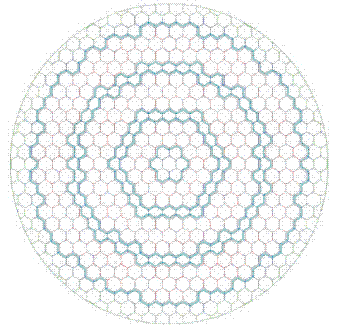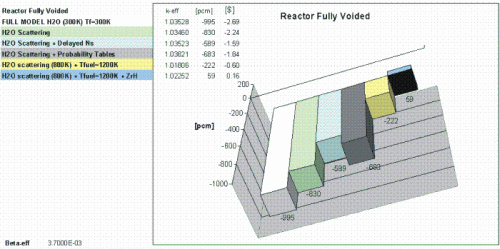MCNP APPLICATIONS
Monte Carlo N-Particle Transport Code System
MCNP is a general-purpose, continuous-energy, generalized geometry, time-dependent, coupled neutron-photon-electron Monte Carlo transport code system.
METHOD OF SOLUTION
MCNP treats an arbitrary three-dimensional configuration of materials in geometric cells (see for instance Figure 1) bounded by first- and second-degree surfaces and some special fourth-degree surfaces.
Pointwise continuous-energy cross section data are used, although multigroup data may also be used. Fixed- source adjoint calculations may be made with the multigroup data option. For neutrons, all reactions in a particular cross-section evaluation are accounted for. Both free gas and S(a ,b ) thermal treatments are used. Criticality sources as well as fixed and surface sources are available. The tallies have extensive statistical analysis of convergence. Rapid convergence is enabled by a wide variety of variance reduction methods. |
Energy ranges are 0-60 MeV for neutrons (data generally only available up to 20 MeV) and 1 keV - 1 GeV for photons and electrons.
APPLICATIONS
Currently MCNP4C is being extensively used to perform full scale analysis of e.g. void reactivity coefficients for complex reactor systems for transmutation
Both 2D and 3D calculations have been performed studying overall and local effects. Extensive uncertainties analyses have also been performed investigating the effect of the application of different cross section data models/treatments (see Figure 2) i.e.:
- Inclusion of delayed neutrons
- Free gas treatment for hydrogen
- Thermal data for hydrogen in water
- Thermal data for hydrogen in zirconium hydride
- Inclusion of probability tables to describe the unresolved resonance region.
|
||
|
Furthermore different cross sections libraries (JEF-2.2, JENDL-3.2, ENDF/B-VI.2, and ENDF/B-VI.7) were used in order to compare the differences among them (see Table 1). |
|
Data library that replaces ENDF/B-6.7 |
ENDF/B-6.2 |
JEF-2.2 |
JENDL-3.2 |
|---|---|---|---|
|
k-eff variation |
0.01114 |
-0.01225 |
-0.01015 |
|
Seed void variation ($) |
-1.03 |
-0.90 |
-0.77 |
|
Total void variation ($) |
-0.67 |
-0.26 |
-1.02 |
This work proved to be extremely useful to outline the differences among cross section data files and of different cross section treatments, and to point out new areas for future research.

